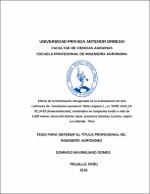Efecto de la fertilización nitrogenada en la aclimatación de tres cultivares de “remolacha azucarera” Beta vulgaris L., cv. SVPE 14-01,14- 02,14-03 (Amaranthaceae), sembrados en trasplante tardío a más de 4000 msnm, sierra del distrito Sarín, provincia Sánchez Carrión, región La Libertad - Perú

Ver/
Descargar
(application/pdf: 2.595Mb)
(application/pdf: 2.595Mb)
Fecha
2018Autor(es)
Maximiliano Gomes, Domingo
Metadatos
Mostrar el registro completo del ítemResumen
El presente trabajo de investigación se realizó en el sector Salitre
caserío Munmalca, distrito Sarín, provincia Sánchez Carrión, región La
Libertad, zona de piso ecológico Bosque Húmedo Montano Subtropical, a una
altitud de 4,043 msnm, 8° 1´ 22.813¨ Latitud Sur, 77° 5´ 57.810¨ Longitud
Oeste, durante los meses de diciembre del año 2014 a setiembre del año 2015.
Se trabajó con tres cultivares monogermen de “remolacha azucarera”. Beta
vulgaris L cv. SVPE 14-01, SVPE 14-02 y SVPE 14-03.
El objetivo principal fue. Estudiar el efecto de cuatro niveles de
fertilización nitrogenada (0, 100, 200 y 300 kg.ha-1) en la aclimatación de tres
cultivares de “remolacha azucarera” Beta vulgaris L (Amaranthaceae),
sembrados en trasplante tardío a más de 4,000 msnm. Para lograr el objetivo,
se instaló el experimento con una densidad de siembra de 200 mil plantas por
hectárea. Se utilizó el diseño de Bloques Completamente al Azar (B.C.A), con
4 tratamientos y 4 repeticiones. Se hizo el análisis de varianza y la prueba
Duncan al 0.05 de significación. Los resultados obtenidos de manera general
indican que los tres cultivares de “remolacha azucarera” Beta vulgaris L.cv
SVPE 14-01,14-02 y 14-03, se adaptan en la jalca del distrito Sarín, provincia
Sánchez Carrión, región la Libertad - Perú, tolerando a las condiciones
medioambientales adversas que presenta la zona, en cuanto se refiere al
prendimiento, el cv SVPE14-01 fue el que alcanzó el mayor promedio; con
relación a los tratamientos el N 2 100 kgNha-1 registro un 100% de prendimiento. Durante la conducción del experimento se registró muy poca
presencia de plagas y enfermedades, se realizaron 5 deshierbos de forma
manual. Para la fertilización se utilizó Urea como fuente de nitrógeno y no se
realizó ningún riego en época de estiaje o secano. The present research work was carried out in the Salitre caserío
Munmalca sector, Sarín district, Sánchez Carrión province, La Libertad region,
Humid Subtropical Humid Forest ecological floor zone, at an altitude of 4,043
meters above sea level, 8 ° 1'22,813¨ South Latitude, 77 ° 5'57.810¨ West
Longitude, during the months of December of the year 2014 to September of
the year 2015. We worked with three monogermen cultivars of ““sugar beet““.
Beta vulgaris L cv. SVPE 14-01, SVPE 14-02 and SVPE 14-03.
The main objective was. Study the effect of four levels of nitrogen
fertilization (0, 100, 200 and 300 kg.ha-1) in the acclimatization of three
cultivars of ““sugar beet““ Beta vulgaris L (Amaranthaceae) planted in late
transplant at more than 4,000 meters above sea level .To achieve the objective,
the experiment was installed with a planting density of 200 thousand plants per
hectare.The design of Completely Random Blocks (B.C.A) was used, with four
treatments and four repetitions. The analysis of variance was made and the
Duncan test at 0.05 of significance.The results obtained in a general way
indicate that the three cultivars of ““sugar beet““ Beta vulgaris L.cv SVPE 1401,14-02 and 14-03, are adapted in the jalca of Sarín district, Sánchez Carrión province, La Libertad region - Peru, tolerating the adverse environmental conditions that the area presents, as regards the seizure, the SVPE14-01 was the one that reached the highest average; in relation to the treatments the N2 100 kgNha-1 record a 100% of capture. During the conduction of the experiment, very little presence of pests and diseases was recorded, five weeding was performed manually. Urea was used as a nitrogen source for fertilization and no irrigation was carried out during the dry or dry season.
Palabras clave
Colecciones
- Ingeniería Agrónoma [99]

